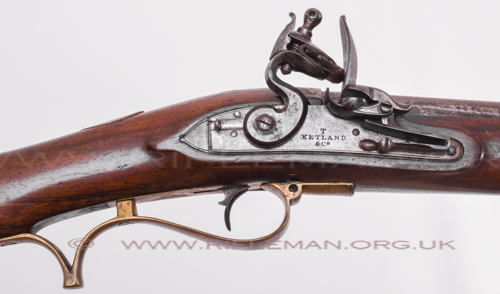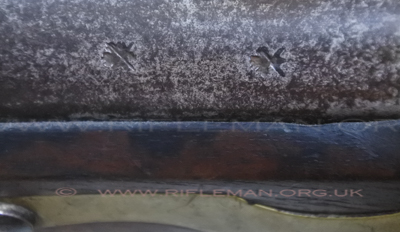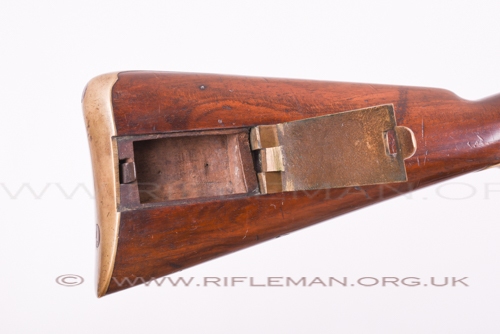Drag horizontally to rotate subject - Click to zoom and drag to pan
Full screen viewing from expansion arrows.
The rifle was made by Ketland gunmakers


Below: the crossed sceptres private proof and view marks of the Birmingham Gunmakers Proof House,
used from 1813 until at least 1851, as the were also to be found on the Pattern '51 Minie rifle.

Below: the seven-groove radiussed rifling, on this rifle with lands wider that the grooves.
The fore-sight blade is dovetailed into the barrel.

The rear-sight has an additional long-range folding leaf.

The butt has the later plain rectangular patch box,
rather than the early two-part version with a circular recess for patches.
These were dispensed with once it was found better to stitch the patches to the balls themselves

The brass-handled volunteer sword bayonet and scabbard, of the 1st. type.
Ordnance bayonets of this type were first issued at the turn of the Seventeenth Century as the Pattern 1800;
the later 2nd. type having a uniformly curved knuckleguard, arrived about five years later.




PRE PUBLICATION NOTES FOR REFERENCE
A brief history. - The T. Ketland & Co. gunmakers proprietor was Thomas Sr., a very successful Birmingham gunmaker. He started in business ca. 1760, and expanded into the export market ca. 1790; he died in 1816. His business was continued until becoming bankrupt in 1821.
W. Ketland was Thomas senior's eldest son. He was originally a partner with his father and William Walker. He petitioned to liquidate his part in the firm in 1800. The partnership was dissolved in 1801. W. Ketland died in 1804 but the business carried on to at least 1831. The story about an earlier W. Ketland gunmaker, going back to the 1740s (Gardner says 1715), is not correct. The directory dates are 1808 to 1831 it is believed that W. Ketland was trading under that name as early as the middle of 1801 and perhaps as early as the end of 1800.
The Philadelphia Ketlands are 2nd son Thomas Jr. and John. Thomas Jr., who resided in Philadelphia from 1789 to 1815. John died there in 1800. They never made guns - there are no American made Ketland guns. The American family were merchants, not engineers, and arms were only a small part of their business.†
† "British Military Firearms 1650 - 1850" - Howard Blackmore - first published 1961
†† "The British Soldiers Firearm 1850-1864" - C.H. Roads, MA., Ph.D. - first published 1964
An interesting adjunct to the history of the Baker rifle was a limited edition miniature marketed by the Royal Armouries complete with bayonet and scabbard. This was likely to have been taking advantage of the publicity for the rifle that was attached to the television series "Sharpe", based on the books by Bernard Cornwell, with the lead played by Sean Bean.

